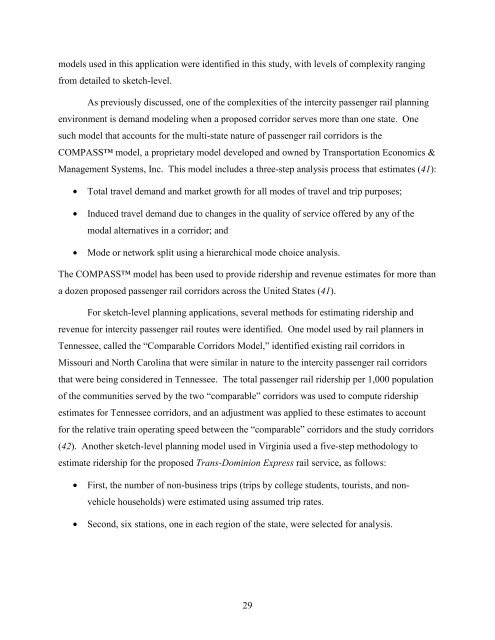Measuring the Benefits of Intercity Passenger Rail: A Study
Measuring the Benefits of Intercity Passenger Rail: A Study
Measuring the Benefits of Intercity Passenger Rail: A Study
Create successful ePaper yourself
Turn your PDF publications into a flip-book with our unique Google optimized e-Paper software.
models used in this application were identified in this study, with levels <strong>of</strong> complexity ranging<br />
from detailed to sketch-level.<br />
As previously discussed, one <strong>of</strong> <strong>the</strong> complexities <strong>of</strong> <strong>the</strong> intercity passenger rail planning<br />
environment is demand modeling when a proposed corridor serves more than one state. One<br />
such model that accounts for <strong>the</strong> multi-state nature <strong>of</strong> passenger rail corridors is <strong>the</strong><br />
COMPASS model, a proprietary model developed and owned by Transportation Economics &<br />
Management Systems, Inc. This model includes a three-step analysis process that estimates (41):<br />
• Total travel demand and market growth for all modes <strong>of</strong> travel and trip purposes;<br />
• Induced travel demand due to changes in <strong>the</strong> quality <strong>of</strong> service <strong>of</strong>fered by any <strong>of</strong> <strong>the</strong><br />
modal alternatives in a corridor; and<br />
• Mode or network split using a hierarchical mode choice analysis.<br />
The COMPASS model has been used to provide ridership and revenue estimates for more than<br />
a dozen proposed passenger rail corridors across <strong>the</strong> United States (41).<br />
For sketch-level planning applications, several methods for estimating ridership and<br />
revenue for intercity passenger rail routes were identified. One model used by rail planners in<br />
Tennessee, called <strong>the</strong> “Comparable Corridors Model,” identified existing rail corridors in<br />
Missouri and North Carolina that were similar in nature to <strong>the</strong> intercity passenger rail corridors<br />
that were being considered in Tennessee. The total passenger rail ridership per 1,000 population<br />
<strong>of</strong> <strong>the</strong> communities served by <strong>the</strong> two “comparable” corridors was used to compute ridership<br />
estimates for Tennessee corridors, and an adjustment was applied to <strong>the</strong>se estimates to account<br />
for <strong>the</strong> relative train operating speed between <strong>the</strong> “comparable” corridors and <strong>the</strong> study corridors<br />
(42). Ano<strong>the</strong>r sketch-level planning model used in Virginia used a five-step methodology to<br />
estimate ridership for <strong>the</strong> proposed Trans-Dominion Express rail service, as follows:<br />
• First, <strong>the</strong> number <strong>of</strong> non-business trips (trips by college students, tourists, and nonvehicle<br />
households) were estimated using assumed trip rates.<br />
• Second, six stations, one in each region <strong>of</strong> <strong>the</strong> state, were selected for analysis.<br />
29
















